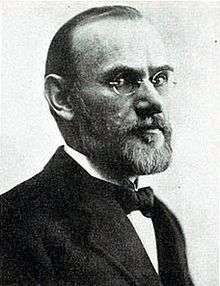Carl Georg Barth

Carl Georg Lange Barth (February 28, 1860 – October 28, 1939) was a Norwegian-American mathematician, mechanical and consulting engineer, and lecturer at Harvard University. Barth is known as one of the foreman of scientific management, who improved and popularized the industrial use of compound slide rules.
Biography
Youth and education
Carl Georg Barth was born in Christiania, Norway. He was the fourth child of Jakob Boeckman Barth (1822-1892), a lawyer and Adelaide Magdeline Lange Barth (1828- 1897), daughter of a Danish clergyman. He received his early education in the public schools at Lillehammer.
He was a graduate from University at Christiania. He later attended the Royal Norwegian Navy technical school at Horten. In 1877, Barth started an apprenticeship in the navy yard at Karljohansvern in Horten.[1]
Career

In 1899, efficiency expert Frederick W. Taylor hired Barth to work with him at Bethlehem Steel Company. Carl Barth helped to develop speed-and-feed-calculating slide rules.[2]
In 1902, Taylor and Barth went to work for William Sellers at the machine tool firm of William Sellers & Company of Philadelphia. An account of their application of slide rules was published in the Transactions of the American Society of Mechanical Engineers in 1904.[4][5]
Barth started in 1905 on his independent career as consulting engineer. Barth became an early consultant on scientific management and later taught at Harvard University. Barth edited articles submitted to International Correspondence School of Scranton, Pennsylvania publication, the Home Study Magazine. In 1909, he undertook the installation of scientific management in the Watertown Arsenal at Watertown, Massachusetts.[6]
Barth was a leftist and anticapitalist. [7]
Family
In March 1882, Barth was married to Henrike Jakobine Fredriksen. They were the parents of three children.
Selected publications
- Barth, Carl G. "Report on Fixing of Rates for Loading Pig Iron by Half Pigs on Buggies in the Yards." South Bethlehem, Pa (1900): 82-84.
- Carl Barth. Slide Rules for the Machine Shop as a Part of the Taylor System of Management. ASME, 1903.
- Barth, C. G. "The Transmission of Power by Leather Belting." Transactions of the American Society of Mechanical Engineers 31 (1909).
- Barth, Carl G. "Testimony of Carl G. Barth." Hearings of the US Commisions on Industrial Relations, 64th Congress, 1st. 1914.
- Barth, Carl G. "Standardization of Machine Tools." Transactions, ASME Vol 38, 1916: 895-922.
- Barth, Carl G. Labor turnover: A mathematical discussion. Carl G. Barth & Son, 1919.
- Barth, C. G. "New Graphical Solution for Time Allowances in Task Setting." Management and Administration: 1943-44.
- Patent
- Barth, Carl G., Henry L. Gantt, and Frederick W. Taylor. "Slide-rule." U.S. Patent No. 753,840. 8 Mar. 1904.
- Barth, Carl G. "Method and means for re-forming wheels having worn treads and flanges." U.S. Patent No. 1,510,819. 7 Oct. 1924.
- Charts
- Barth, C. G. "Carl," Diagram of Functionalized Routing."." Chart 180.
References
- ↑ Carl G. Barth, 1860–1939: A Sketch (Florence M. Manning. Norwegian-American Historical Association. Volume XIII: Page 114
- ↑ US Patent 753,840, 1904
- ↑ e.g. FW Taylor, The Principles of Scientific Management (1911) ch 2, 57
- ↑ Frederick Winslow Taylor, Class of 1883 (Stevens Institute of Technology) "Archived copy". Archived from the original on 2010-06-26. Retrieved 2009-11-05.
- ↑ An Interpretive Review of 20th US Machining and Grinding Research (M. Eugene Merchant. Cincinnati, Ohio: Techsolve, Inc. 2003)
- ↑ Taylorism at the Watertown Arsenal (Foundations and Trends in Technology)
- ↑ Drucker, P. F. (1993). The Rise of the Knowledge Society. The Wilson Quarterly (1976-), 17(2), 52–71. doi:10.2307/40258682
Further reading
- Bjork, Kenneth Saga In Steel And Concrete – Norwegian Engineers In America (Northfield, Minnesota: Norwegian-American Historical Association, 1947)
External links
| Wikimedia Commons has media related to Carl Georg Barth. |
- Carl G. Barth, 1860-1939: A Sketch By Florence M. Manning